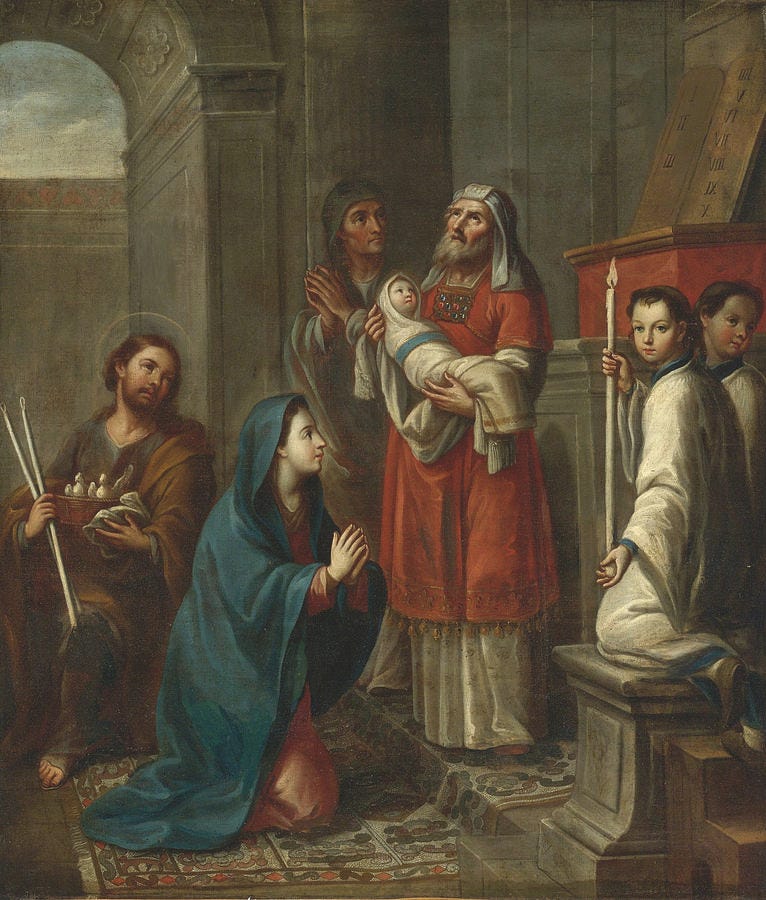Lumen Ad Revelationem Gentium: A Candlemas Antiphon
The Candlemas antiphon of the Canticle of Simeon
February 2 is the Feast of the Purification of the Blessed Virgin Mary. This feast is also called the Presentation of Jesus, since it commemorates the day on which Our Lady and St. Joseph presented Jesus in the Temple in accordance with the Mosaic Law (see Lk 2:22-39 DRB). The feast is also called Candlemas due to the Church’s long-standing tradition of blessing candles on this day.
The feast traces its roots to at least the fourth century AD in the Eastern churches, and it soon spread to the Western churches. The custom of celebrating the feast with candles can be traced to the middle of the fifth century.1 Traditionally, the Church uses pure beeswax candles for liturgical use and for Candlemas blessings. The virginal wax symbolizes the pure “Flesh of our Lord; the wick, which is within, is [H]is Soul; the flame, which burns on the top, is [H]is Divinity.”2

Thus, the Feast of Candlemas is rich with symbolism, and the chants that traditionally accompany the Mass for today’s feast are beautiful. Much can be said about each of the chants, but I want to turn particular attention to the antiphon chanted during the distribution of the candles, Lumen ad revelationem gentium. The words to this antiphon are the Canticle of Simeon, which he prayed upon seeing the Christ Child in fulfillment of God’s promise: “Now [T]hou dost dismiss [T]hy servant, O Lord, according to [T]hy word in peace; Because my eyes have seen [T]hy salvation, Which [T]hou hast prepared before the face of all peoples: A light to the revelation of the Gentiles [lumen ad revelationem gentium], and the glory of [T]hy people Israel” (Lk 2:29-32).

The last line of the above passage from Scripture is repeated as the antiphon. Antiphonal singing was especially common in the Middle Ages, and this antiphon for Candlemas thus demonstrates the universal character of the Catholic Church, uniting us with the faithful of the past two millennia. A careful study of the antiphon’s notation reveals that the notes soar higher when speaking of divine things such as Christ’s light (lumen) and glory (gloriam). Similarly, the notes descend when speaking of mankind, specifically the Gentiles (gentium) and Israel.

My Gregorian Chant professor once pointed out that this notation pattern is a common stylistic tendency in Gregorian Chant; the notes will soar higher when referring to the divine and descend lower when referring to created beings. In many chants, this distinction is even more evident than in this Candlemas antiphon, but it nonetheless assists our understanding of the passage being chanted. When we hear this antiphon, we are listening to the Word of God being chanted, and the notation is designed to aid in our meditation upon the passage. In the case of this Candlemas antiphon, the chant helps us recall Christ’s glory as He came to illuminate the darkness of the world, taking on the lowliness of human flesh in order to redeem mankind from the bonds of sin and death.
You can listen to a beautiful recording of the Lumen ad revelationem gentium here:
Editors of Encyclopedia Britannica, “Candlemas,” in Encyclopedia Britannica, 29 December 2023, at www.britannica.com.
Dom Prosper Gueranger, The Liturgical Year, vol. 3 (Fitzwilliam, NH: Loreto Publications, 200), 474.




Beautiful. Thank you for sharing the recording. I found the group on Spotify and am enjoying their whole album.
Oh my, that recording.... thank you for sharing this. Wow.